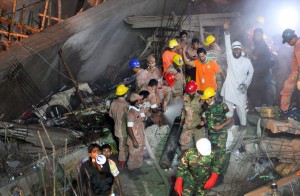
Rescue workers call for help while fire fighters, center, hose out a fire which broke out in a garment factory building that collapsed Wednesday in Savar, near Dhaka, Bangladesh, Sunday April 28, 2013. More than 100 hours after the garment factory block collapsed, rescuers in Bangladesh tunneled into the rubble on Sunday to find a woman whose feeble cries for help raised hopes of more miracles. AP PHOTO/WONG MAYE-E
DHAKA– The death toll in Bangladesh’s worst industrial disaster rose to 482 on Friday after 41 bodies were pulled from the wreckage of an eight-storey building overnight, the army said.
Major Harunur Rashid of the army control room, which was set up to coordinate the rescue operation, told AFP that recovery efforts had gathered pace and the “death toll now stands at 482”.
The building housing five garment factories collapsed near capital Dhaka on April 24, trapping around 3,000 people. At least 2,437 people have been rescued, Rashid said.
Rashid said the use of cranes and bulldozers to cut through the mountain of concrete and mangled steel by army and fire brigade teams had speeded up the recovery of bodies from the lower floors.
Clutching photographs of their missing loved ones, scores of distraught relatives massed at the disaster site for a tenth day.
The overall toll is expected to top 500 after officials said on Wednesday that 149 people were still unaccounted for.
Police have arrested eight people including the owner of the Rana Plaza compound and four garment factory owners for forcing people to work on April 24 despite cracks appearing in the structure the previous day.
Authorities Thursday suspended the mayor of Savar for approving the building and failing to shut the factories when cracks appeared.
The disaster, the worst industrial tragedy in the country’s history, came just five months a fire killed 111 people in a nearby garment factory.
UK retailer Primark, Italy’s Benetton and Spanish firm Mango admitted that they had placed orders in the factories based in the compound, triggering a backlash in many countries in the West.
Bangladesh is the world’s second-largest garment exporter after China. The industry accounts for 80 percent of the country’s exports and more than 40 percent of its industrial workforce.